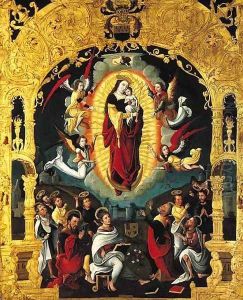Lanceloot Blondeel Paintings
Lanceloot Blondeel, also known as Lancelot Blondeel, was a versatile Flemish painter, architect, and designer, born in Poperinge, then part of the Spanish Netherlands, in 1498. He played a crucial role in the development of the Renaissance style in the Low Countries, blending Northern European Gothic traditions with influences from Italian Renaissance, which he likely absorbed through travels or direct contacts with Italian artists. His work is characterized by a detailed approach to both religious and secular subjects, showcasing a unique blend of intricate Gothic elements and the emerging new Renaissance ideals of proportion, perspective, and human anatomy.
Blondeel’s career was primarily based in Bruges, where he became a master in the Guild of St. Luke by 1519, indicating his recognition as a professional artist. His contributions were not limited to painting; he was deeply involved in the design and execution of public pageants, temporary decorations for festivals, and even worked on the design of monumental structures, showing his versatility and creativity. Among his architectural contributions, the most notable is his work on the St. Salvator's Cathedral in Bruges, where his architectural interventions are still admired today.
Throughout his life, Blondeel maintained connections with leading figures of the time, including the humanist and printer Simon Stevin and the painter Pieter Pourbus. These relationships were crucial for the exchange of ideas and the dissemination of Renaissance humanism in the region. His art often depicted complex religious themes and classical mythology, enriched with allegorical elements, showing his deep engagement with the intellectual currents of his time.
Blondeel's legacy is significant in the context of Flemish art, as he helped to introduce and disseminate Renaissance styles and motifs in the Northern Renaissance, bridging the gap between the late Gothic tradition and the emerging new artistic ideals. He passed away in Bruges in 1561, leaving behind a body of work that continues to be studied for its artistic and historical significance. His contributions to both the visual arts and architecture underscore his importance as a key figure in the transition to the Renaissance in the Low Countries.
